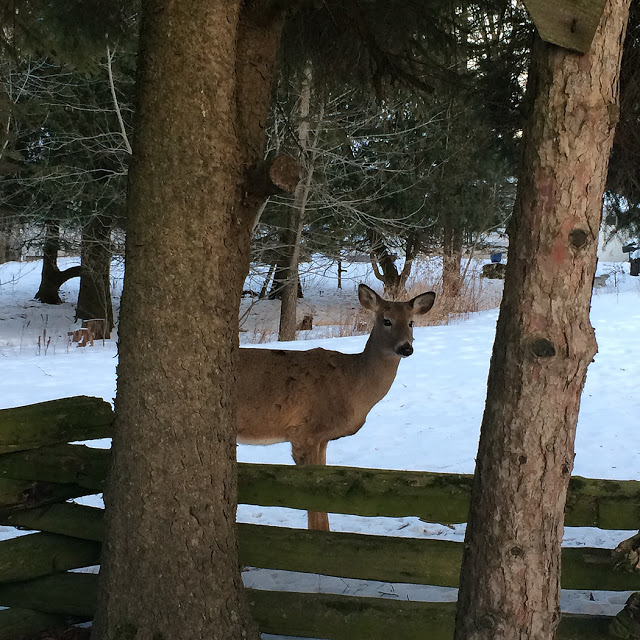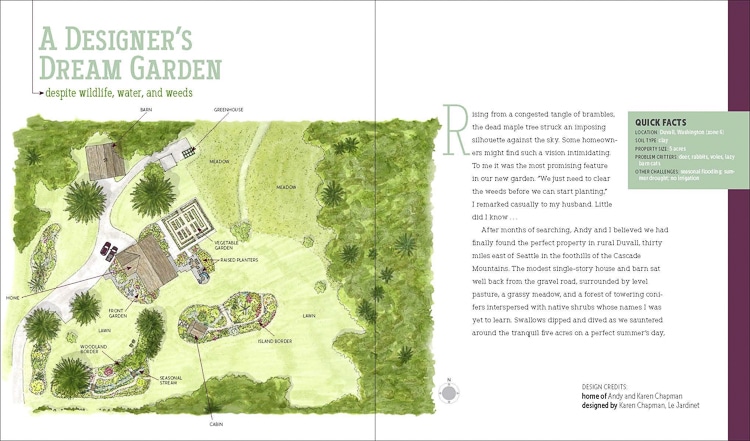I have written thousands of words on this blog about deer: plants deer avoid, ways to fend off deer attacks, homemade deer spray, complaining about deer. Lots of complaining about deer.
And a lot of you reading this have deer issues too. I know because not only do you commiserate (particularly with the complaining), but also because I get a lot of questions about deer. Gardeners who have deer issues are a very big group.
This post may include affiliate links. See my complete disclosure here.

Which is why Karen Chapman’s book Deer-Resistant Design probably wasn’t written specifically for me, but you could have fooled me. Because this is exactly the kind of book that is deserving of a spot on a crowded bookshelf and one I’ll go back to often.

Focus for a moment not on the “deer” portion of the title, but rather the “design” bit. There are other books (and, um, blogs) that cover deer management, but they often focus on plant lists and fence building. But Chapman brings us breaking deer-related news: You can have a beautiful garden even if you have deer in your area and you don’t need a fence.
No one, including Chapman, is going to argue that a fence is the best way to protect your garden from deer, but they often aren’t a realistic solution. In Deer-Resistant Design, those of us who are plagued by deer will find ways to have a beautiful garden despite deer.
13 INSPIRING GARDENS
Case studies of 13 gardens from zones 5 to 8 demonstrate a number of approaches to managing deer in a garden. Each includes beautiful photos and a lovely illustration of the garden’s layout created by Chapman’s talented daughter. An accomplished garden designer herself, Chapman is able to not just identify what works in a design, but explain why it works, making it easier to incorporate the ideas into your own space.

Of course some of the gardens rely on the plants many of us know to be generally deer resistant like lavender, grasses and alliums. Other featured gardens have gardeners who, like me, rely heavily on deer repellents. But there are tricks to creating a planting strategy that makes gardening with deer tolerable.
Proof of this concept lies in a New York garden that is perhaps the least likely candidate to be featured in a book called Deer-Resistant Design. The owners are collectors of hostas and daylilies, having about 600 of the former and 400 of the latter. My first thought was that clearly this was the work of masochistic gardeners, but it turns out it works. In fact it is absolutely lovely.
PLANTS THAT WORK
At the end of each featured garden is a list of the gardener’s top 10 plants in their garden. Chapman includes not just the typical important information about each plant, but also a deer resistance rating. I’d like to lobby the plant world for that rating to be included on every plant label, please. Many of the plants are very hardy, so there’s plenty in this book for gardeners in even very cold zones.
Chapman is known for her creative container designs (they featured prominently in her first two books on foliage co-written with Christina Salwitz and she has a popular online container design course), so I was delighted to find a section on deer-resistant containers full of photographic inspiration.
In a book full of gorgeous images, it may seem odd to fawn over an index, but you’ll have to indulge me for a moment. Every plant mentioned in the book makes the index, listed by both its common name and its botanical name. This means that this book is not just reference when considering a design, but also when considering a plant. I happen to know that Chapman enjoys the occasional glass of red wine (possibly because I once picked her brain about deer-resistant evergreens over an earthy cabernet), and I will gladly buy her one the next time I see her to thank her for going the extra mile on the index.
As deer populations grow and move from rural areas to the suburbs and even cities, managing them is something an increasing number of gardeners need to face. Deer-Resistant Design proves that beautiful gardens and deer can coexist.
[custom_code name=”amazon”]
